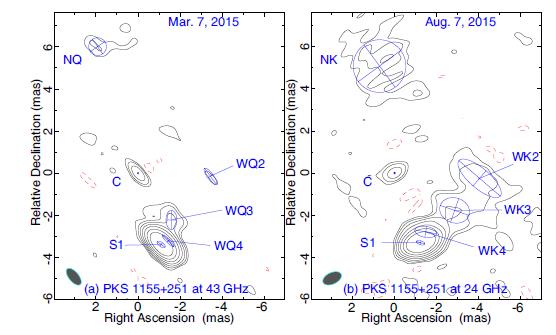Recently, research fellow from Xinjiang Astronomical Observatory (XAO) Xiang Liu and his research partners have gained results on quasar PKS 1155 + 251 with Very Long Baseline Array at 24 and 43 GHz frequencies. The results are published in the <Monthly Notices of the Royal Astronomical Society> (MNRAS , 2017, 471,1873)
The high frequency VLBI results show that this quasar has a flat spectrum at the two frequencies of the brightest component S1 of southern complex along with jet (WK) emission to the northwest (as shown in Fig.1) besides the central component C, and the southern component has also been found to show strong radio variability in the previous 15GHz multi epoch VLBI observations. The radio core C revealed in the previous VLBI observations remains compact with a flat spectrum in our sub milli-arcsecond resolution images.
This paper prefers that the southern component might be a jetted nuclei resulting from a secondary massive black hole (BH) accretion. At the frequency lower than 22GHz, the source with VLBI observing results have been explained as a traditional central radio nucleus with twin jets i.e. the radio structure as a compact symmetric object (CSO). The new results cannot be fully explained based on the CSO scenario. The researchers have proposed that this might be a super massive binary BH system, the southern component S1 may be hosted by the second radio nucleus (super massive BH) which jetted to the northwest, with 12 pc separation from the primary nucleus C.
If the binary black hole system can be confirmed by higher frequency VLBI observation and other bands, it will be the second case of massive binary BH system in parsec scales, the quasar B0402 + 379 is known as the first pc-scale BBH system.
Coauthors: Dr Jun Yang, the Onsala Space Observatory, and colleagues from Shanghai Astronomical Observatory and Peking University. PhD student Xiaolong Yang completes the data processing under the guidance of Professor Xiang Liu.
Article Link: http://adsabs.harvard.edu/cgi-bin/nph-abs_connect?library&libname=liu_xiang_XAO&libid=51f73d7866

Fig.1: VLBA total intensity images of PKS 1155 + 251 at 43 (left) and 24 GHz (right), red shift 0.2.